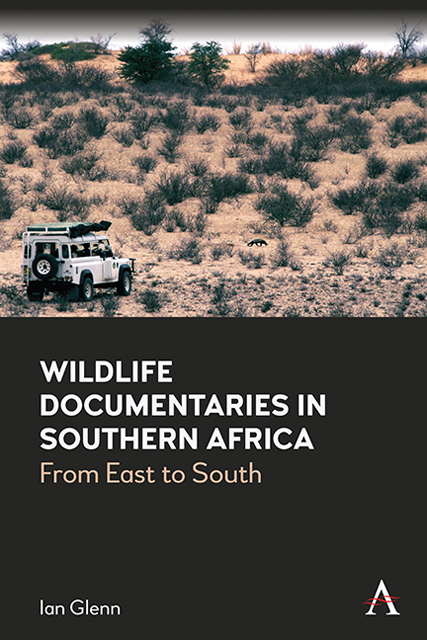Book contents
- Frontmatter
- Dedication
- Contents
- List of Figures
- Acknowledgements
- Introduction
- Chapter 1 What do the Critics Say?
- Chapter 2 A Theoretical Coalition?
- Chapter 3 Gone South: From East to Southern Africa
- Chapter 4 Private Lodges, Infrastructures and Guides
- Chapter 5 Going South: The Results
- Chapter 6 The Early History
- Chapter 7 The South Africans Enter the Game
- Chapter 8 Michael Rosenberg and Partridge Films
- Chapter 9 David and Carol Hughes
- Chapter 10 The Bartletts in the Namib, the Liversedges in Botswana
- Chapter 11 John Varty, Elmon Mhlongo and Londolozi
- Chapter 12 Richard Goss and Kim Wolhuter
- Chapter 13 Dereck and Beverly Joubert
- Chapter 14 Other Major Contributors
- Chapter 15 Going Live: Africam And Wildearth
- Chapter 16 Craig and Damon Foster
- Chapter 17 Must Love Animals?
- Chapter 18 The Social Turn
- Chapter 19 The Future of the Genre
- Chapter 20 The Influence of the Genre
- Conclusion
- Filmography
- Plates
- References
- Index
- Frontmatter
- Dedication
- Contents
- List of Figures
- Acknowledgements
- Introduction
- Chapter 1 What do the Critics Say?
- Chapter 2 A Theoretical Coalition?
- Chapter 3 Gone South: From East to Southern Africa
- Chapter 4 Private Lodges, Infrastructures and Guides
- Chapter 5 Going South: The Results
- Chapter 6 The Early History
- Chapter 7 The South Africans Enter the Game
- Chapter 8 Michael Rosenberg and Partridge Films
- Chapter 9 David and Carol Hughes
- Chapter 10 The Bartletts in the Namib, the Liversedges in Botswana
- Chapter 11 John Varty, Elmon Mhlongo and Londolozi
- Chapter 12 Richard Goss and Kim Wolhuter
- Chapter 13 Dereck and Beverly Joubert
- Chapter 14 Other Major Contributors
- Chapter 15 Going Live: Africam And Wildearth
- Chapter 16 Craig and Damon Foster
- Chapter 17 Must Love Animals?
- Chapter 18 The Social Turn
- Chapter 19 The Future of the Genre
- Chapter 20 The Influence of the Genre
- Conclusion
- Filmography
- Plates
- References
- Index
Summary
My wife Les Aupiais is, among other things, a magazine editor. In 2008, she asked me to interview and help her write about wildlife filmmaker Kim Wolhuter (Aupiais and Glenn 2008). When I spoke to Wolhuter and asked him about what had inspired him, he asked if I knew Carol Hughes as she and her late husband David had been the leading wildlife filmmakers of their time. When I confessed not, he put me in touch with her.
Carol invited me to visit her in her house on the banks of the Crocodile River, just outside the Kruger Park. When I walked into her study, I saw six Emmy statues and a Golden Panda, the British prize for the best wildlife film of the year (Figures 1 and 2). David and she had won the very first Golden Panda, in 1982, for their film Etosha: Place of Dry Water (1979). I had no idea that any South African filmmaker had won that many awards and suspect that very few South Africans do. When South African filmmakers win awards, local media usually make a fuss, yet here there were signs that the leading wildlife filmmakers of their time were hardly recognized in their own country At that moment, I felt, indignantly, that a study of wildlife documentary in South Africa was long overdue. Much later, it is even more so.
The big idea of this book is that, starting in the early 1970s, wildlife films made in Southern Africa, mostly but not exclusively by Southern Africans, started winning major international awards and mark a crucial move away from East Africa as the centre of African wildlife film. More than that, they start influencing modern trends in the genre and provide some of its most important achievements. This study tries to understand the importance of the genre and understand why the Southern African achievements have often been marginalized in popular or scholarly accounts. In part, then, this is a quest for justice for a Southern perspective and for achievements from the global South.
- Type
- Chapter
- Information
- Wildlife Documentaries in Southern AfricaFrom East to South, pp. 1 - 14Publisher: Anthem PressPrint publication year: 2022

